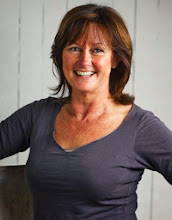There were lots of scientific bits, with research that backed up their theories, then lots that had absolutely no scientific evidence to support it at all (such as sitting down on the floor and standing up again with your legs crossed, not using any other part of the body, as a sign that you are likely to live longer), very disappointing. A yoga instructor called into Radio 4 the following morning when this very item was being discussed, and pointed out that to attempt this was likely to cause injury - ankles and knees not being in line apparently.
Then there were the pieces that related to food - Angela was shocked to find she has visceral fat around her organs, but she was going to get rid of it by taking inulin every day (not a pile of old lentils, but just a teaspoon of powder) - no explanation as to what it is, what is does or how you may be able to get it from other foods?
Inulin is a dietary fiber, a naturally occurring oligosaccharide (several simple sugars linked together) belonging to a group of carbohydrates called fructans. Unlike other carbohydrates, inulin is non-digestible, so it passes through the small intestine, and ferments in the large intestine. Through this fermentation process it becomes healthy intestinal micro flora and acts as a prebiotic, feeding probiotics (friendly bacteria) in the gut. In addition to promoting a healthy gastrointestinal tract, inulin may also help with constipation.
Chicory root is the best source of inulin, but there are lots of other foods containing inulin that are easier to include in our everyday diets - leeks, garlic, onions, asparagus, bananas, wheat, Jerusalem artichokes and dandelion root.
For the brain we were told that purple foods would be beneficial, having studied a group of centenarians in the Far East. Again, there was no mention of other aspects of their lifestyle (they were shown playing croquet and whizzing around on a scooter), or other aspects of their diet. I expect the supermarkets are now being inundated with requests for purple sweet potatoes!
Anthocyanins are members of the flavonoid family of phytochemicals, found in plant foods. They provide the bright red-orange to blue-violet colours found in many fruits and vegetables - blackcurrants, blackberries, blueberries, red cabbage, elderberries, cherries, purple grapes, blood oranges and aubergines especially.
Plants produce anthocyanins as a protective mechanism against environmental stressors, such as ultraviolet light, cold temperatures, and drought. This production of anthocyanins in roots, stems, and especially leaf tissues is believed to provide resistance against these environmental hazards, making them a potent antioxidant. Research has shown anthocyanins may have a beneficial effect against cardiovascular disease, cognitive function and cancer.
To increase your intake of both nutrients, try these delicious low sugar muffins - perfect for a breakfast or brunch snack. They are also dairy-free. If you can find purple sweet potatoes great, if not orange ones are also fine in this recipe.
Banana and Blueberry Muffins
Makes 12
1 banana, peeled and chopped
4 eggs
100g light muscovado sugar
150ml olive oil
200g wholemeal self-raising flour
1 tsp ground cinnamon
175g carrots, peeled and grated
160g sweet potato, peeled and grated
150g blueberries
- Pre-heat the oven to 190°C / Gas mark 5. Line a muffin tin with 12 paper cases.
- Mash the banana in a large bowl then whisk in the eggs and sugar.
- Slowly whisk in the oil.
- Fold in the remaining ingredients (do not over-mix).
- Divide between the paper cases and bake for 30-35 minutes, until risen and golden.
- Cool on a rack and store in a air-tight container - these also freeze well.




No comments:
Post a Comment